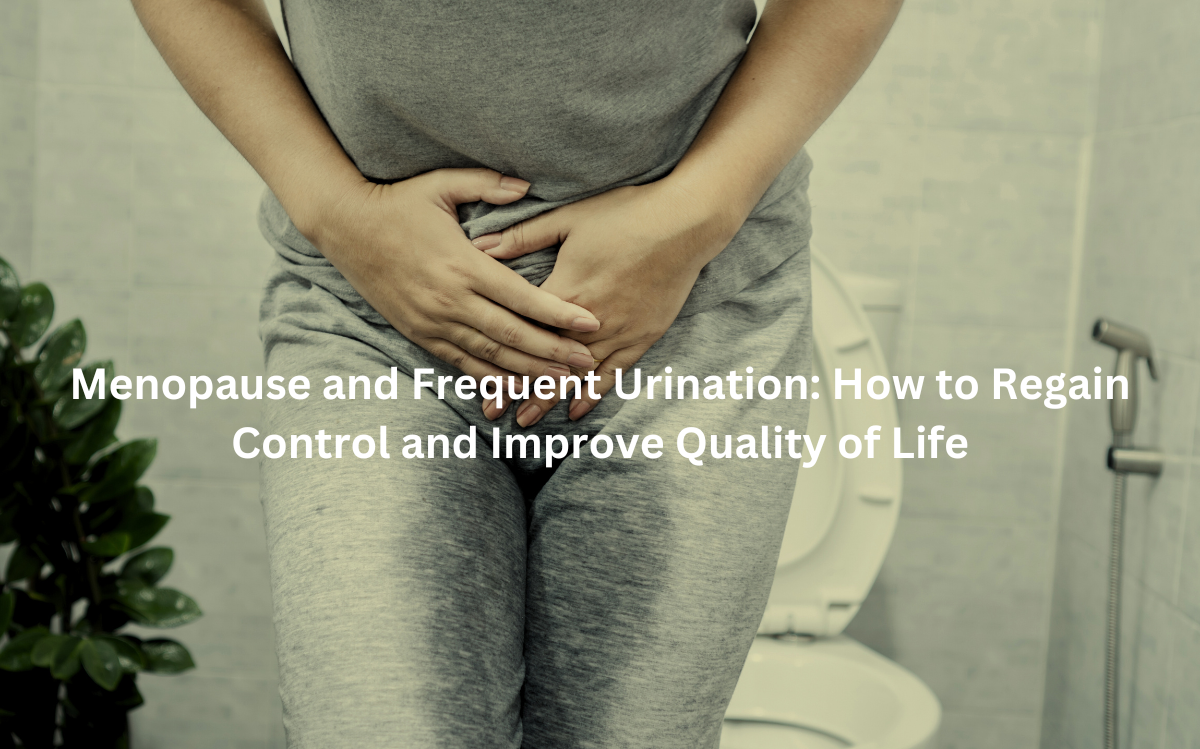Uncover effective strategies to manage frequent urination during menopause and restore bladder control.
Frequent urination is a common and frustrating symptom of menopause. As oestrogen levels drop, many women experience urinary issues that disrupt their daily lives. (1)
Fortunately, there are various treatment options, including pelvic floor exercises, hormone therapy, and lifestyle adjustments, that can help regain control over bladder health.
Key Takeaways
- Hormonal Changes Impact Bladder Health: Menopause-related drops in oestrogen can weaken pelvic muscles, leading to urinary issues.
- Effective Treatments Are Available: Hormone Replacement Therapy (HRT), vaginal estrogen, and pelvic floor exercises can significantly improve symptoms.
- Lifestyle Changes Matter: Maintaining a healthy weight, staying hydrated, and exercising regularly can prevent or alleviate urinary symptoms.
Understanding Menopause and Its Impact on Urinary Health
Menopause can often feel like a set of dominoes falling, where one change leads to another—none of them particularly pleasant. One of the more surprising effects women experience is on their urinary health. As oestrogen levels drop, women can face a range of bladder-related issues.
Urinary incontinence, frequent urination, and even urgency can all become part of the menopausal landscape.
The connection between declining oestrogen and bladder health is fairly direct. Oestrogen plays a critical role in maintaining the strength and integrity of the pelvic muscles.
As its levels decrease, these muscles can weaken, leading to less control over bladder function. This hormonal shift is what sets the stage for many of the urinary symptoms seen during menopause.
But it’s not just about weakened muscles. Lower oestrogen can also affect the urinary tract, making the lining of the bladder thinner and less resilient.
This combination of changes often results in symptoms like increased urgency, frequent urination, and sometimes, incontinence. These issues can be both physically uncomfortable and emotionally taxing.
Common Urinary Symptoms During Menopause
The range of urinary symptoms women face during menopause is extensive. These symptoms can vary greatly in severity, with some of the most common being:
- Frequent urination: Those moments when a trip to the bathroom seems endless.
- Urge incontinence: The sudden, intense need to rush to the toilet.
- Stress incontinence: Leaking urine during physical activity, sneezing, or coughing.
Another common symptom is nocturia, which disrupts sleep by causing women to wake up multiple times during the night to use the bathroom. This constant disruption can:
- Affect overall health.
- Lead to fatigue and irritability during the day.
What makes these issues especially challenging is their impact on daily life. Women might feel:
- Self-conscious about a potential accident.
- Distracted during work meetings, trying to avoid the need for bathroom breaks.
In severe cases, urinary symptoms can affect sleep quality, leaving women exhausted during the day.
Pelvic Floor Health and Bladder Control
The pelvic floor muscles are the unsung heroes when it comes to bladder control. They’re responsible for keeping the bladder, uterus, and rectum in place. When these muscles weaken, due to factors like childbirth or the hormonal changes of menopause, bladder function can become compromised. (2)
Pelvic floor exercises—commonly known as Kegels—can help strengthen these muscles and regain bladder control. These exercises involve:
- Contracting and releasing the muscles that normally stop the flow of urine.
- Being simple, discreet, and easy to do anywhere, making them accessible for most women.
However, the decline in oestrogen levels during menopause directly affects the pelvic floor muscles. Without adequate oestrogen, these muscles become:
- Less toned.
- Less responsive, increasing the likelihood of urinary issues.
Kegels can still help, but some women might need additional help. Hormonal treatments may be necessary to manage symptoms effectively.
Treatment Options for Menopause-Related Urinary Symptoms
There are several ways to treat urinary issues related to menopause. These options range from lifestyle changes to medications and hormonal treatments, with varying degrees of effectiveness depending on the individual.
Hormone Replacement Therapy (HRT)
For many women, Hormone Replacement Therapy (HRT) offers a relief from urinary symptoms by helping to restore oestrogen levels.
This is particularly helpful for women who experience both menopausal hot flashes and urinary issues. By addressing the root cause—low oestrogen—HRT can improve the strength of the pelvic floor muscles, as well as the overall health of the urinary tract.
However, HRT is not for everyone. Women with certain medical histories may need to explore alternative treatments.
Vaginal Estrogen
For those dealing with vaginal dryness—a common complaint during menopause—vaginal estrogen can help.
This treatment directly targets the vaginal tissues, alleviating dryness and improving bladder health by reducing urogenital atrophy (the thinning and weakening of tissues). It’s a targeted approach, delivering estrogen directly to the affected area, without the widespread effects of systemic HRT.
Bladder Training
Bladder training is another effective way to manage overactive bladder symptoms, like urgency and frequency.
It involves gradually increasing the time between bathroom visits to help the bladder hold more urine. Over time, the bladder becomes less sensitive, and the need for frequent trips to the bathroom decreases.
Medications
In some cases, medications can be helpful. Anticholinergics, for example, work by reducing bladder spasms, while beta-3 adrenergic agonists can help relax the bladder muscle, reducing urgency and frequency.
Managing Urinary Tract Infections (UTIs) During Menopause

As if urinary symptoms weren’t enough, menopause also increases the risk of urinary tract infections (UTIs). Hormonal changes lead to vaginal dryness, which can make the urethra more susceptible to bacteria.
Plus, the weakening of the pelvic floor muscles can make it harder to fully empty the bladder, allowing bacteria to grow.
Hydration is key here—drinking plenty of water helps to flush out bacteria before it can cause infection. Regular hygiene is also important, as is using vaginal estrogen to prevent dryness. When UTIs do occur, it’s crucial to seek treatment promptly to avoid complications.
Alternative and Complementary Treatments for Urinary Symptoms
While traditional treatments can be effective, some women may prefer to explore alternative and complementary options.
Herbal Remedies
Herbal supplements like saw palmetto and pumpkin seed extract have gained popularity for their potential to support urinary health. Saw palmetto is believed to help balance hormones and support bladder function, while pumpkin seed extract may aid in reducing incontinence.
Acupuncture and Probiotics
Acupuncture has been touted as a potential treatment for a range of menopause-related symptoms, including urinary issues.
Some studies suggest it can help regulate bladder function and reduce the severity of incontinence. Similarly, probiotics might help by balancing the bacteria in the urinary tract, though more research is needed in this area.
Cognitive Behavioral Therapy (CBT)
Finally, non-hormonal therapies like Cognitive Behavioral Therapy (CBT) can be useful, especially when urinary symptoms start to take a mental and emotional toll. CBT can help women manage the anxiety and stress that often accompany bladder issues, improving overall wellbeing.
Long-Term Management of Urinary Health Post-Menopause
Once menopause has passed, ongoing attention to urinary health is still essential. It’s important to continue pelvic floor exercises to maintain bladder control and prevent the weakening of pelvic muscles. Women should also focus on maintaining a healthy weight, as obesity can exacerbate urinary symptoms.
In addition, staying hydrated and managing stress levels can play a significant role in urinary health. Women should consult with a healthcare professional to monitor any changes in their symptoms and adjust treatment plans as necessary.
When to Seek Medical Help for Urinary Symptoms
While many urinary symptoms are manageable with lifestyle changes and treatments, there are times when medical help is necessary.
If a woman experiences persistent pain, blood in her urine, or worsening incontinence, it’s time to consult a doctor. These symptoms could signal a more serious issue, such as a urinary tract infection or bladder prolapse.
Healthcare professionals are well-equipped to provide a diagnosis, recommend treatment options, and help manage complex cases. If symptoms persist, a referral to a specialist might be necessary.
Conclusion
Menopause may bring about a host of uncomfortable symptoms, but urinary issues don’t have to be a permanent part of the experience.
By understanding the hormonal changes at play, exploring available treatment options, and making lifestyle adjustments, women can regain control of their bladder health and improve their overall quality of life.
With the right approach, menopause-related urinary symptoms are manageable—and women don’t have to face them alone.
FAQ
What is the connection between menopause and frequent urination?
Frequent urination is a common symptom of menopause due to reduced estrogen production, which affects bladder muscles and urinary frequency. As estrogen levels drop, the muscles around the bladder become weaker, leading to increased urgency and even leaking urine.
Older women, especially those experiencing the symptoms of menopause, may also find that urinary problems become more frequent, including a sudden urge to urinate. Some may experience urge incontinence, which can make it hard to control the need to urinate.
Can Kegel exercises help with menopause-related urinary issues?
Yes, Kegel exercises can help strengthen the bladder muscles and reduce urinary problems associated with menopause. These exercises involve contracting and relaxing the pelvic muscles to improve bladder control.
Regular Kegel exercises may help prevent leaking urine and reduce the symptoms of stress incontinence. They are particularly beneficial for postmenopausal women who experience symptoms like frequent urination or urge incontinence, where the urge to urinate comes on suddenly.
Consult your care provider for proper technique and advice on managing urinary frequency.
How does reduced estrogen impact urinary function during menopause?
Reduced estrogen levels during menopause directly impact the bladder muscles, making them weaker and less responsive. This decline in estrogen can lead to urinary frequency and increased pressure on the bladder.
Women may feel the urge to urinate more often, especially if they also experience vaginal atrophy, which can further affect the urinary system. Lack of estrogen may also increase the risk of developing conditions like stress incontinence and urge incontinence, which are common in older women.
Can hormonal changes cause painful urination during menopause?
Yes, hormonal changes, particularly the decline in estrogen during menopause, can lead to painful urination. The lack of estrogen affects the vaginal tissues, making them thinner and less lubricated, which can result in vaginal atrophy.
This condition can cause discomfort during urination, especially during sexual intercourse. In addition to painful urination, women may also experience urinary frequency and a sudden urge to urinate, making these symptoms of menopause challenging to manage. Consult your care provider for guidance on managing these symptoms.
How can I manage frequent urination and other urinary problems during menopause?
To manage frequent urination and other urinary problems during menopause, maintaining a healthy body mass, staying hydrated, and performing Kegel exercises can help strengthen the pelvic floor muscles. Additionally, focusing on blood sugar and sugar levels can reduce the risk of urinary issues related to diabetes.
You may also want to consider nerve stimulation therapy to help with bladder control. If you’re experiencing symptoms like urinary frequency, urge incontinence, or painful urination, it’s important to talk to your care provider for tailored advice and treatment.
References
- https://pmc.ncbi.nlm.nih.gov/articles/PMC4876519/
- https://thebms.org.uk/wp-content/uploads/2024/04/09-BMS-ConsensusStatement-Urogenital-atrophy-MARCH2024-A.pdf

Leave a Reply